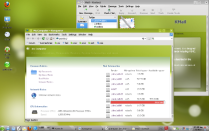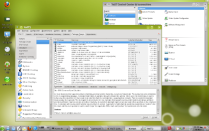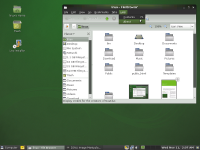openSUSE 11.2
Right behind Mandriva and Ubuntu, openSUSE 11.2 arrived as scheduled after almost a year of development. This incremental version increase has enough new features to warrant a closer look. Sometimes adding so many new features between minor versions can backfire. Is that what happened this time with openSUSE 11.2? Or are we seeing some early effects of the newly sanctioned community contributions?
So What's New?

The first thing anyone might notice is the new theme. Developed by KDE's Nuno Pinheiro, it has a very "Airy" look and feel to it. I say theme, but I really mean the background and application graphics because KDE still hasn't offered a decent window decoration for KDE 4 and openSUSE 11.2 is using KDE's default. I don't want to spend too much time on appearances, but while most have found the desktop unattractive, I have seen a few positive remarks for the olive and peridot greens.
Speaking of KDE 4, KnetworkManager recently received an overhaul and the bulk of the work was done by openSUSE developer Will Stephenson, with contributions from Fedora, Kubuntu, and other developers. This rewrite has been in the works for quite a while and it is still not fully completed now. Struggles with the interface plagued development and improvements sit at the top of the todo list for future releases. As it is, it's built with QT4 and fits in with the KDE Plasma desktop adequately. The current interface hides most available wireless connections detected from the default view, instead only listing those previously used. Other little goodies include setting custom icons on a per connection basis, configurable tooltips, one-click connects, and the option of forcing password input on each connect for users.
The YaST Control Center has been ported to QT4 for the KDE desktop as well. It still resembles the GTK version for GNOME quite a bit and is said to be more consistent with KDE System Settings, but somehow it doesn't feel very polished. The fonts are atrocious, and I had to configure some of my hardware (scanner and TV card) more than once for it to actually take effect. This is very uncharacteristic for openSUSE and I have to wonder what happened. Also new this time is WebYaST, an easy-to-use remote management and administration interface.

The YaST2 Software Manager also saw a few tweaks for this release. The GUI features a new View tab that's actually a drop down menu containing various package viewing choices. Underneath, Zypper now functions a bit faster and includes the option of downloading only. Also new for this release is openSUSE's equivalent to a dist-upgrade. A live update can be performed from the GUI or command line, although reports have stated that the command line route is more reliable at this point.
The Firefox KDE integration has received quite a bit of publicity during the development cycle. Basically, that consists of setting Firefox as the default KDE browser and calling KDE applications when a trigger is clicked. For example, Firefox will open Okular when a PDF link is clicked. This ties in with file dialogs and application selection screens, mimetype and protocol handling (such as mailto), and proxy settings. It also uses KDE icons and widgets and can add RSS feeds to Akregator. Several other distributions have switched their KDE default browser to Firefox recently as well, but openSUSE is the only one to try and integrate it so completely. More features are being planned in this area for future releases. As in many distributions, "check for updates" is disabled, but this is the only time I can really see a good reason why.
Some changes can be seen in the installer as well. KDE has been returned to the default desktop choice of the install DVD. GNOME is listed first, but KDE is ticked. Apparently this was done to lessen the number of choices a new user might have to make during the install process. Ext4 is the new default filesystem and Btrfs is available for particularly brave souls. Full disk encryption is now available for the security minded. And for netbook users, the live CDs can be copied to and booted from USB memory sticks.
At the desktop, KDE's Strigi and Nepomuk are disabled by default to lessen system requirements and improve performance. In contrast to KDE, the new GNOME theme is receiving quite a bit of praise. Pidgin remains the included instant messenger for GNOME instead of migrating to Empathy like some others, and new microblogging clients were added for the two major desktops, Gwibber and Choqok. The primary desktops are KDE 4.3.1, GNOME 2.28, Xfce 4.6.1, and Enlightenment 1.0. OpenOffice.org has been upgraded to 3.1.1, Firefox to 3.5.4, and GIMP 2.6.7. Under the hood is Linux kernel 2.6.31.5, Xorg X Server 1.6.5, and GCC 4.4.1.

Issues Encountered
openSUSE has traditionally been a very polished and professional system; rock solid underneath with pretty GUIs on top. However, 11.2 has slipped some. After installation, the fonts were very ugly and distracting. I've seen complaints in the past about openSUSE fonts, but I've never personally been affected. But with 11.2, my desktop was almost unusable until I tweaked the fonts. However, try as I might, I still could not bring openSUSE 11.2 fonts up to par with my other systems.
It's not uncommon for sound to only emit from my two rear speakers in some Linux distributions. I don't consider this a problem, really, since the front is usually a mirror of the rear with my card, but when sound only comes from one of the rear speakers, then I've got to say that something is wrong somewhere. My sound card is detected with similar output as in other distributions, the same ALSA modules are used, and the mixer channels were thoroughly reviewed. So, at this point, it's a mystery why this old and usually well supported card went oblong in this release.
I've also had real issues with Akregator in KDE. Admittedly, it's always been unstable in KDE 4, but I've been experiencing more frequent crashes in openSUSE. It seems to crash, taking the rest of Kontact with it, five or six times a day. Sometimes it loses all the articles pulled in previously making it quite a chore to continue using it.
KDE settings, in general, have been acting strangely too. For example, losing settings between openings, settings that never take or change the behavior, and settings that won't change - they appear to change, but don't take effect and when I check back, the original settings are depicted in the input box as if I'd never touched them.
As far as performance, which seems to be a hot topic this year, 11.2 does seem to boot faster, but I'm not seeing anything impressive in its KDE. Many issues found might have been lessened if KDE had been updated to one of the newer releases, because 4.3.1 (even with some 4.3.2 backports) still has many performance and functionality issues.
Conclusions
Overall this version of openSUSE acts more like a point-0 release or even a release candidate. Everything feels rough around the edges and as though lots more work is needed. There's no dispute that openSUSE developers are the most aggressive between minor version releases, but this is the most dramatic effect I've witnessed from them. Polish and excellence have always been trademarks of openSUSE, so much so that I've come to expect only that. So, it's shocking to have seen an openSUSE released in such rough condition.
Having said that, I still look forward to 11.3 and have confidence that it will be up to openSUSE's usual standards. In Linux, developers are always fighting "the damned if you do and damned if you don't" paradox. If they don't release when users expect, then they risk losing lots of momentum, much like PCLinuxOS experienced in 2008 and early 2009. Or on the other hand, if they release on time, even though they know there are issues, they risk the bad press and decreased user confidence like that seen with the latest release (or two) of Ubuntu.
I would like to give openSUSE the benefit of the doubt but my best recommendation is for folks to wait for the next release, especially if they are KDE users. GTK/GNOME users might have better luck. However, overall, 11.2 isn't the best example of its work and we should wait for the next release so that it can sand down the rough edges.
| Index entries for this article | |
|---|---|
| GuestArticles | Linton, Susan |
Posted Nov 19, 2009 4:41 UTC (Thu)
by roblucid (guest, #48964)
[Link]
In general my experience is that releases always have rough edges, about 10 weeks later they are vastly improved by updates which QA didn't allow into the Gold Master version DVD.
openSUSE 11.2 core has much more solid feel than past releases, and has been happily early-adopted by many on forum. Rough edges left generally go, within a few months by accepting updates.
Posted Nov 19, 2009 8:24 UTC (Thu)
by wstephenson (guest, #14795)
[Link] (2 responses)
Thanks for the shout out re KNetworkManager. I'd qualify the 'interface struggles' observation quoted from the KNetworkManager dot article by saying these actually took place in the 11.1 release cycle. For 11.2 we had a direction and it was pretty much plain sailing.
Fonts are one of those things it seems hard to 'get right out of the box' on everyone's screen. Every time we tweak font hinting settings on a release, a different section of the userbase screams because fonts just went ugly on their default install, and subjectively one person's 'clean' is 'spidery' to another, who prefers 'smudgy'. What kind of 'atrocious' was it for you? FWIW the default fonts look great to me on a ThinkPad X60, a HP Mini 2140 and a HP LP2065, and the customised fonts that you used on the screenshots look fine to me, if a bit clumpy on the Konqueror/Kontact menu and toolbars.
The Akregator crashes are likely bko#116482 or bko#133407. The Akregator developers acknowledge there are design problems in the way feeds are stored and have said they aren't in a hurry to fix them, because this code will be removed when Akregator is ported to Akonadi (for KDE 4.5). Redesigning apps' backends for them is kinda out of distributions' remit, so I guess you'll see this anywhere. As damage limitation, I might disable the Kontact integration.
But which KDE settings refused to apply? I can't believe that the KDE app settings infrastructure is generally broken, so if a few apps are advertising settings that they don't save, we want to know about it and fix them.
Posted Nov 19, 2009 14:17 UTC (Thu)
by nix (subscriber, #2304)
[Link]
Posted Nov 24, 2009 20:16 UTC (Tue)
by Baylink (guest, #755)
[Link]
Posted Nov 19, 2009 17:21 UTC (Thu)
by morhippo (guest, #334)
[Link] (3 responses)
https://bugzilla.novell.com/show_bug.cgi?id=227511
It's a WONTFIX actually, that prevents any serious commercial use of this distribution... I mean come-on - no updates behind an authenticated proxy?
Posted Nov 19, 2009 18:07 UTC (Thu)
by proski (subscriber, #104)
[Link]
Posted Nov 23, 2009 1:48 UTC (Mon)
by roblucid (guest, #48964)
[Link] (1 responses)
1) Using zypper, "zypper up" updates system, "zypper pach" should work quicker and seems intended to install updates with security or recommended bug fixes.
2) Use YaST Online Update - A GUI tool similar
What corporate would insist the desktop user, needs to have a functioning "Updater Aplet"? The title to this comment seems an exaggeration to me.
https://bugzilla.novell.com/show_bug.cgi?id=227511#c26 shows update through authenticating proxy got fixed, even if the "Updater Aplet" wasn't.
If you looked at .curlrc when trying 11.2 release, then it was probably wasted time, as curl(1) has been replaced with aria2c by the package update stack.
Posted Nov 24, 2009 20:15 UTC (Tue)
by Baylink (guest, #755)
[Link]
Posted Nov 21, 2009 8:04 UTC (Sat)
by nettings (subscriber, #429)
[Link] (1 responses)
as to your criticism of release numbering, well, i share that. i remember times where a .0 would bring basically a wallpaper color change, and .1 upgraded major kernel release and libc :) looks like their release numbers are dictated by marketing...
Posted Nov 22, 2009 12:09 UTC (Sun)
by niner (subscriber, #26151)
[Link]
So, no. A SuSE user could never rely on major/minor version numbers to
Posted Nov 24, 2009 11:58 UTC (Tue)
by jospoortvliet (guest, #33164)
[Link] (1 responses)
Another thing I note is that apparently compositing is off, I thought this suse version enabled it by default?
Last, the font thing - besides normal users not caring much about that and it being as much about personal preference as a real issue, I must say I'm getting a bit tired with all the complaining about fonts...
Otherwise, nice article. It is unfortunate to hear the new suse is so unpolished, I would indeed have expected more from suse.
Posted Nov 24, 2009 12:29 UTC (Tue)
by jospoortvliet (guest, #33164)
[Link]
Posted Nov 25, 2009 8:04 UTC (Wed)
by thoeme (subscriber, #2871)
[Link]
As for the fonts: After downloading the MS TTF and another free TTF font
Thome
openSUSE 11.2
openSUSE 11.2 KDE team responds
openSUSE 11.2 KDE team responds
openSUSE 11.2 KDE team responds
openSUSE 11.2 - not usable for corporate users
Here's your chance to save the world :-)
openSUSE 11.2 - not usable for corporate users
openSUSE 11.2 - not usable for corporate users
openSUSE 11.2 - not usable for corporate users your eye
very desktop-centric review..
but i think you are giving them heat for "cosmetic" issues - i can see how you come to dislike what you describe, but hey, oS is also a kick-ass server distro, with excellent xen integration, and many other goodies. sure, there is not much news in "infrastructure behind the scenes is a good as ever", but your review seems a tad too desktop-centric to give them justice. to me, it's amazing how little oS sucks when used in such diverse settings as desktop workstation, low-latency audio machine, headless router, xen hypervisor, mail, web, stream and j2ee server, ..., you name it.
very desktop-centric review..
year and minor version numbers for the (quarterly) releases within a year.
They changed it when release cycles got longer, but I don't know how the
current system works. If there is any.
actually tell you how much changed in a release. It's much better to just
read the release notes.
openSUSE 11.2
openSUSE 11.2
http://news.opensuse.org/wp-content/uploads/2009/11/800px...
http://news.opensuse.org/wp-content/uploads/2009/11/OS11....
openSUSE 11.2
install and the other doing a system upgrade (11.1->11.2). I found only 2
problems with this:
a) During installation of 11.2 on a second disk I wanted GRUB to be
installed in the MBR of this second disk. I got an error that installing
GRUB on disk "/dev/sdb97543" failed (or a similiar silly number). GRUB was
installed fine, I manually had to correct the entry in GRUB's menu.lst.
b) After I upgraded an existing 11.1, the upgrade did not update the
GRUB "default" setting: It still wanted to boot the old kernel which
failed to find mydisk and dropped me into the restricted console. Again
after manually correcting this problem in menu.lst, it worked fine.
package, the fonts are fine, clear and nice to look at. So IMO 11.2 is a
worthwile upgrade, especially if you run 11.0.

